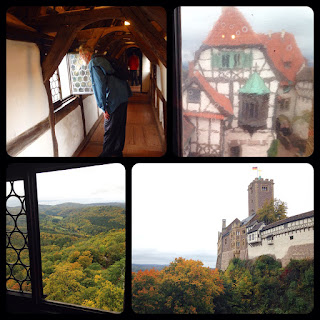Luther spent ten months hiding out in this room where Kathy is standing (although only the whale-bone footstool is actually from Luther's time). There, Luther translated the New Testament from the original Greek into the everyday German of the people. Along the way he also codified the "high German" that is still spoken today, distilled from the sixteen-or-so different German dialects in use at the time.
The train left at 12:00 noon, and took about 45 minutes to go the 30 miles or so, stopping at every station. When we got to the station, we hopped on the bus up to the castle, which took another 20 minutes. When we got to the castle bus stop, we still had a steep 10-minute climb to get to the castle itself. We got there just as the English tour was kicking off. Since we hadn't seen the ticket office on the way in, the tour guide waited for us while we went back and got our tickets. Both of us were out of breath.
The tour started in the oldest part of the castle, from about 1200, called the Knights Room. This room was quite plain, but it, and the dining hall next door, are the only parts of the castle that have been kept or restored using the original elements. The rest of the castle reflects the 19th-century romantic re-imagining of the middle ages, and are much more ornate.
The Byzantine-like mosaics in Elisabeth's Bower illustrate the life of St. Elisabeth of Hungary, the most notable resident of the castle other than Luther. The mosaics themselves, though, are early 20th century, created on behalf of Kaiser Wilhelm II of WWI fame. They are beautiful, though.
The two festival halls, the Sängersaal (or minstrel's hall) and the Festssaal or festival hall are done up in an over-the-top recreation of the middle ages. The minstrel's hall (above) is notable as the setting for the medieval version of an American-Idol-like competition, immortalized in Scene II of Wagner's opera Tannhäuser.
The festival hall (above) is even more richly decorated. It so impressed "Mad" King Ludwig of Bavaria, that he copied the design when he built his romantic medieval re-creation at Neuschwanstein Castle south of Munich. And, of course, a hundred years after that, Walt Disney "borrowed" Ludwig's design to create Sleeping Beauty's Castle at Disneyland.
After the tour, and a visit to the museum, we retraced our steps. We climbed down the mountain, caught the bus, waited for the train and got back to Erfurt about 5:30. We picked up some dinner on the way home. In the morning we'll pack up and head for Berlin, where we'll be boarding an airplane to Crete.








so enjoying your travel missives :-)
ReplyDeletefeel like I'm there...